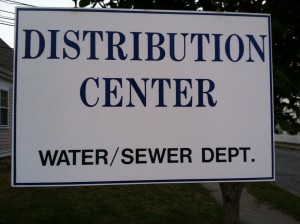Mattapoisett Water and Sewer Superintendent Nick Nicholson oversees an infrastructure that is all about clean water and wastewater. That would seem pretty straight forward – right? But toss in the complexities of underground pipes, valves, pumps, aging systems, river flows, aquifers, rainfall, budgets, and oh yes, state government regulations and now you’ve got a job others might find overwhelming. Nicholson’s passion for his profession keeps him fueled and focused on the needs of the town while keeping a weary eye on the State House. And it was a comment he recently made while attending a Finance Committee meeting that precipitated questions that needed asking. His comment was, “…and they want to impose water restrictions across the board…”
What he was referring to, I subsequently learned, is that the Massachusetts Department of Environmental Protection (DEP) believes the time has come to impose water use restrictions that could have wide-reaching implications.
Nicholson said that a new water management act presently being drawn up by the DEP would mandate and set use levels at 62 gallons per capita (per person per day) and would dial back fresh water pumping levels to those used nearly a decade ago. He said that given the larger customer base that nearly all cities and towns now have due to population growth, those earlier use levels would require water restrictions such as the discontinuation of outdoor watering.
So, why now, I asked? What is driving this at the state level? Nicholson said there has been a ‘state water management act’ in place since the 1980s. Sometime in the 1990s, that act expired. Since then, the DEP has been toiling to put updated rules and regulations in place. Concurrently, the DEP has received increasing pressure from various interest groups who have lobbied that decreased river flow and dropping water table levels need to be taken into consideration. “The new triggers are flows and rivers,” he said.
Explaining further, he said that the data being used to write these proposed new regulations is most likely flawed. Speaking to Mattapoisett specifically, he said that we get our water from the aquifer and not the Mattapoisett River. The water shed area for the aquifer is fed by rivers and streams and is impacted by seasonal changes. Typically, he says the summer months are drier. Adding to the problem of using river flow as a measure for assigning water use rates is the fact that the Mattapoisett River has a clay bottom that does not allow for good absorption into the aquifer.
In spite of his growing concerns that new state legislation would force his office to shut down outdoor watering during the summer season when water levels are typically at their lowest, he is encouraged that Mattapoisett’s residents are currently only using 50 to 52 gallons of water per capita – well below the state mandated rate of use.
From what he and the other Massachusetts Water Works Association members have seen so far, the new legislation would direct cities and towns to implement state conservation plans with no latitude to implement municipal policies that would be based on local conditions. It would be the state rules over the town’s reality, period.
Summer water use is double that of other seasons due to more residents and visitors consuming fresh water resources, gardening, and keeping lawns green, Nicholson stated. He continued, “I’ve never been a fan of automatic sprinkler systems.” He believes that if people haul hoses and sprinklers around a lawn, they tend to be more conservative in their watering of grasses versus automatic irrigation systems that silently spin water meters. Having said that, however, he was happy to report that, “Mattapoisett is not a big water user. Our residents are pretty well educated (on conservation issues) and they want to do the right thing.” Regardless, using less water will not and does not equate to lower water rates. “We still need money to handle debt services,” Nicholson stated.
Contributing to Mattapoisett’s conservative use of water, he believes that more homes are equipped with devices that lower volume flow such as toilets, shower heads, and new water meters that help to detect leaks leading to lost water. The total amount of water used on the average per day by the town is 200,000 gallons. The water and sewer department uses a rate of 12,000 cubic feet (one cubic foot equals 7.48 gallons of water) per household to set the water and sewer rates. The more accurate average is around 8,800 cubic feet he said, noting the public’s willingness to conserve water.
So what does the future hold? For now, Nicholson along with other concerned superintendents throughout the state are keeping a close eye on the DEP. Nicholson’s advice: “Use as much as you need, but don’t waste it.”
This brought me back to when I was a child and was taught the following by my Father, whose conservative use of all utilities equated to money left in his pocket: “Shut the lights off when you leave the room” and “Don’t let the water run down the drain while you brush your teeth…” That is some old-fashioned advice that would serve us well today.
By Marilou Newell
